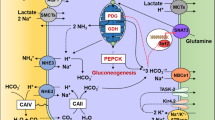Abstract
The physiology and pathophysiology of renal H+ ion excretion and urinary buffer systems are reviewed. The main focus is on the two major conditions related to acid–base metabolism that cause kidney stone formation, i.e., distal renal tubular acidosis (dRTA) and abnormally low urine pH with subsequent uric acid stone formation. Both the entities can be seen on the background of disturbances of the major urinary buffer system, \( {{\rm NH}}_{{{\rm 3}}} {\hbox{ + H}}^{{\hbox{ + }}} {\hbox{ }} \leftrightarrow {\hbox{ NH}}^{{\hbox{ + }}}_{{{\rm 4}}} \). On the one hand, reduced distal tubular secretion of H+ ions results in an abnormally high urinary pH and either incomplete or complete dRTA. On the other hand, reduced production/availability of \( {{\rm NH}}^{{\hbox{ + }}}_{{{\rm 4}}} \) is the cause of an abnormally low urinary pH, which predisposes to uric acid stone formation. Most recent research indicates that the latter abnormality may be a renal manifestation of the increasingly prevalent metabolic syndrome. Despite opposite deviations from normal urinary pH values, both the dRTA and uric acid stone formation due to low urinary pH require the same treatment, i.e., alkali. In the dRTA, alkali is needed for improving the body’s buffer capacity, whereas the goal of alkali treatment in uric acid stone formers is to increase the urinary pH to 6.2–6.8 in order to minimize uric acid crystallization.

Similar content being viewed by others
References
Rose BD, Post TW (2001) Clinical physiology of acid–base and electrolyte disorders, 5th edn, chapt 11. McGraw-Hill, New York
Lackson BA, Ott CE (1999) Integrated medical sciences: renal system, 1st edn, chapt 7. Fence Creek Publishing, Madison/CT
Hamm LL, Alpern RJ (1996) In: Coe FL et al (eds) Kidney stones: medical and surgical management, chapt 12. Lippincott-Raven, Philadelphia
Rose BD, Post TW (2001) Clinical physiology of acid–base and electrolyte disorders, 5th edn, chapt 19. McGraw-Hill, New York
Simpson DP (1983) Citrate excretion: a window on renal metabolism. Am J Physiol 244:F223–F234
Pak CY (1991) Citrate and renal calculi: new insights and future directions. Am J Kidney Dis 17:420–425
Erwin DT, Kok DJ, Alam J, Vaughn J, Coker O, Carriere BT et al (1994) Calcium oxalate stone agglomeration reflects stone-forming activity: citrate inhibition depends on macromolecules larger than 30 kDa. Am J Kidney Dis 24:893–900
Hess B, Jordi S, Zipperle L, Ettinger E, Giovanoli R (2000) Citrate determines calcium oxalate crystallization kinetics and crystal morphology— studies in presence of Tamm–Horsfall protein of a healthy subject and a severely recurrent calcium stone former. Nephrol Dial Transplant 15:366–374
Hamm LL, Hering-Smith KS (2002) Pathophysiology of hypocitraturic nephro-lithiasis. Endocrinol Metab Clin North Am 31:885–893
Hess B, Michel R, Takkinen R, Ackermann D, Jaeger Ph (1994) Risk factors for low urinary citrate in calcium nephrolithiasis: low vegetable fibre intake and low urine volume to be added to the list. Nephrol Dial Transplant 9:642–649
DuBose TD Jr (2004) In: Brenner BM (ed) Brenner and Rector’s the kidney, 7th edn, vol 1, chapt 20. Saunders, Philadelphia
Mattle D, Hess B (2005) Preventive treatment of nephrolithiasis with alkali citrate—a critical review. Urol Res 33:73–79
Coe FL, Strauss AL, Tembe V, Le Dun S (1980) Uric acid saturation in calcium nephrolithiasis. Kidney Int 17:662–668
Pak CYC, Sakhaee K, Peterson RD, Poindexter JR, Frawley WH (2001) Biochemical profile of idiopathic uric acid nephrolithiasis. Kidney Int 60:757–761
Kamel KS, Cheema-Dhadli S, Halperin ML (2002) Studies on the pathophysiology of the low urine pH in patients with uric acid stones. Kidney Int 61:988–994
Sakhaee S, Adams-Huet B, Moe OW, Pak CYC (2002) Pathophysiologic basis for normouricosuric uric acid nephrolithiasis. Kidney Int 62:971–979
Abate N, Chandalia M, Cabo-Chan AV Jr, Moe OW, Sakhaee K (2004) The metabolic syndrome and uric acid nephrolithiasis: novel features of renal manifestation of insulin resistance. Kidney Int 65:386–392
DeFronzo RE, Tobin JD, Andres R (1979) Glucose clamp technique: a method for quantifying insulin secretion and resistance. Am J Physiol 233:E214–E223
Ford ES, Giles WH, Dietz WH (2002) Prevalence of the metabolic syndrome among US adults: findings from the third National Health and Nutrition Examination Survey. JAMA 287:356–359
Author information
Authors and Affiliations
Corresponding author
Rights and permissions
About this article
Cite this article
Hess, B. Acid–base metabolism: implications for kidney stosne formation. Urol Res 34, 134–138 (2006). https://doi.org/10.1007/s00240-005-0026-0
Accepted:
Published:
Issue Date:
DOI: https://doi.org/10.1007/s00240-005-0026-0




